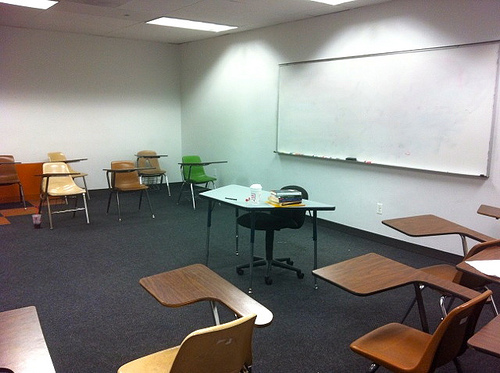
Teaching as Learning, Classroom as Community
[flickr id=”8168006594″ thumbnail=”medium” overlay=”false” size=”original” group=”” align=”center”]
I recently spoke to Ames Hawkin’s Theory and Praxis class about my experience being a Graduate Student Instructor and the transition from teaching Writing and Rhetoric I to teaching Writing and Rhetoric II. My hope is that I was able to give some valuable insight to my peers who will begin teaching in the spring, but it was also a beneficial experience for me. I got to talk about my process as a teacher and to verbalize my own thoughts and theories behind the assignments that I give my students and the materials that I share with them.Teaching constantly asks me to question myself, my practices, and my presence in the classroom. I am always learning and correcting, adding onto and deleting from the course schedule. Often, I go into the classroom, completely prepared, and the class takes a different route; students are interested in a specific topic, and we don’t get around to all of the material that I had intended to cover. These moments in class are my favorite moments, when students run with the discussion, start talking to one another, and whatever the activity is that I had planned gets pushed back or doesn’t end up happening. And, that’s completely okay. Student discoveries and student voices are the most important part of teaching, and the best way to get to those moments is to allow the class to get a little of course, and that is fine by me.
[flickr id=”8167978163″ thumbnail=”medium” overlay=”false” size=”original” group=”” align=”center”]
The transition from Writing and Rhetoric I to Writing and Rhetoric II was a learning experience for me. I didn’t have as much time to spend with the material that I would eventually be teaching for Writing and Rhetoric II, and it took a little trial and error to find my groove, to alter and add to the course materials so that I felt that I was prepared to teach them. I use the Ethnographic Inquiry method to teach Writing and Rhetoric II, which allows students to pick a research site that they are interested in and asks them to use ethnographic methods of observation to explore a question of inquiry.
This semester, I added a few additional assignments to my syllabus, but my favorite assignment and the one that I think creates a sense of community in the classroom is the Origins Presentation. I took a class with CM Burroughs last spring, and at the top of each class we would give an origins presentation—a mix of family history and what compelled us to write. What I loved about this assignment was that every student got a chance to start the class discussion. Every student’s voice was heard, and it created a community, a space for everyone to share their thoughts and writing, and a space where we could talk about our process and assess how we came to be who we were as thinkers and as writers.
I want the same thing for my students. So, at the top of each class session, two students give a five-minute presentation about their origins, using the different lenses with which we are approaching each writing assignment throughout the semester. This gives them a chance to engage with important terms using their own experiences and to think critically about their own belief systems, and it starts each class session with student voices and experience. My students each know a little something about each other, and I feel that the classroom becomes a community space, a comfortable space for sharing ideas, as a result of this assignment.
[flickr id=”8168006638″ thumbnail=”medium_640″ overlay=”true” size=”original” group=”” align=”center”]
I’m always tweaking this and deleting that in order to make sure that my students are engaging with each other and each other’s writing in the classroom. Teaching affords me the opportunity to constantly be learning while I’m working. And, I think that the moment that I am not learning—that I’m not surprised or don’t get that flutter when a student has a lightbulb go off—that will be the moment I don’t teach anymore. It’s too soon to tell if that moment will come, but for now, I’m just enjoying the opportunity to teach while in grad school and to see my students thinking, collaborating, and starting to see themselves as deep thinkers and writers or, at the very least, not wanting to run for the door at the thought of having to think deeply and write.
